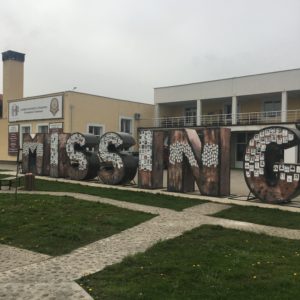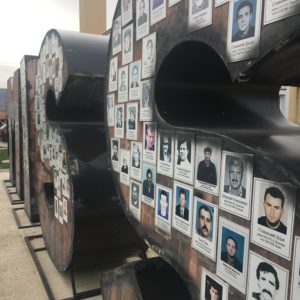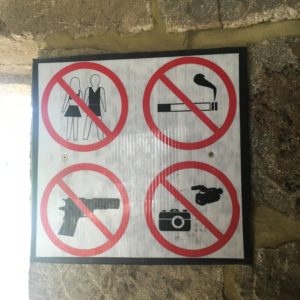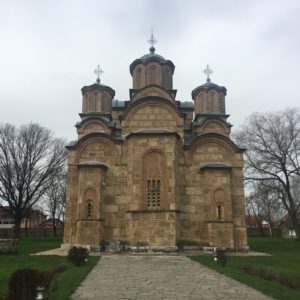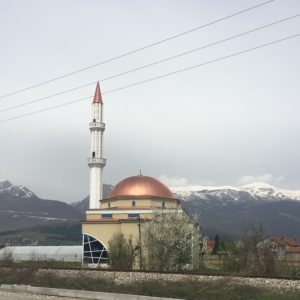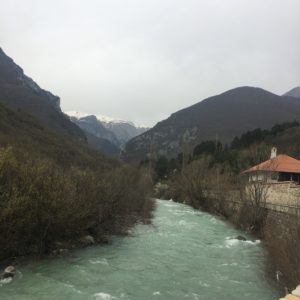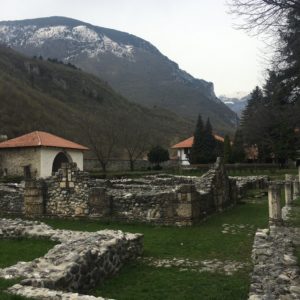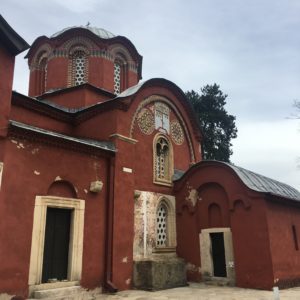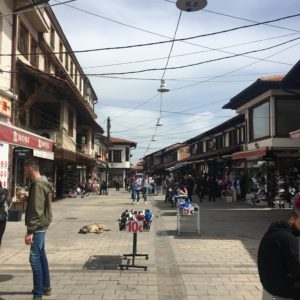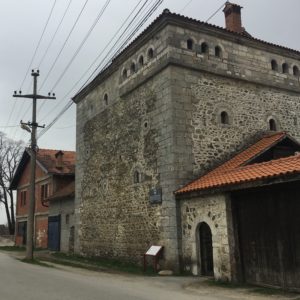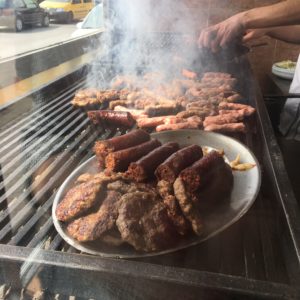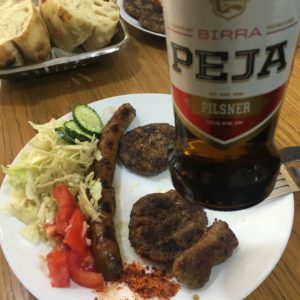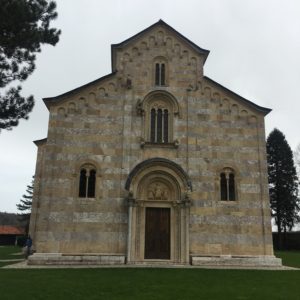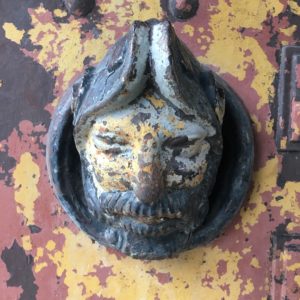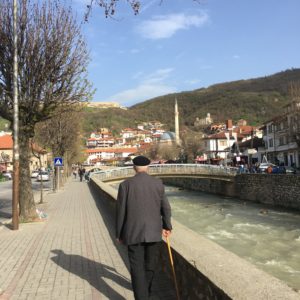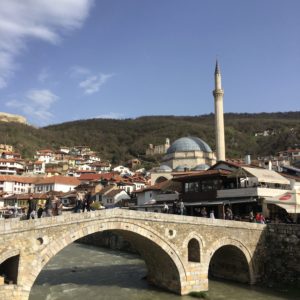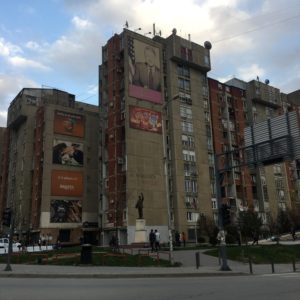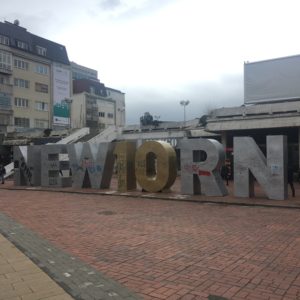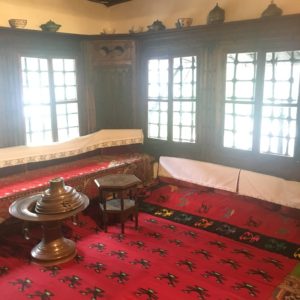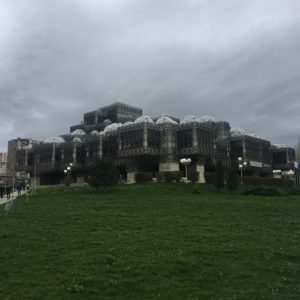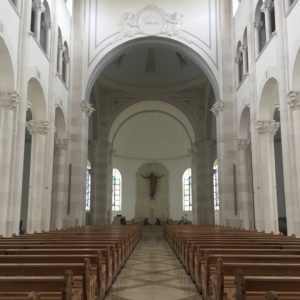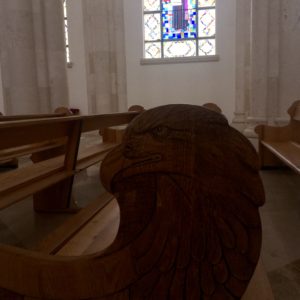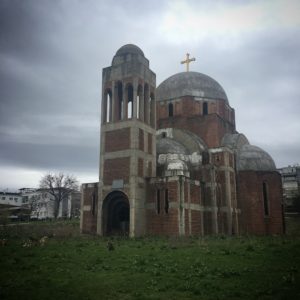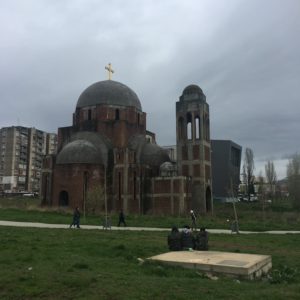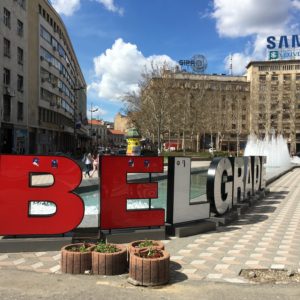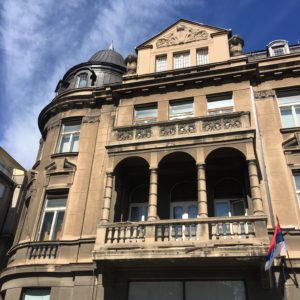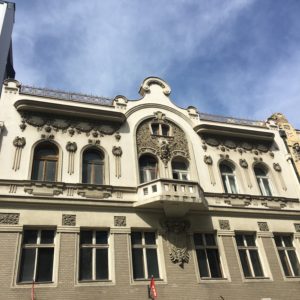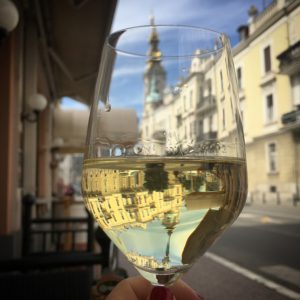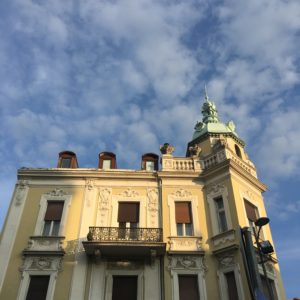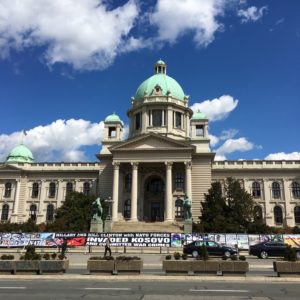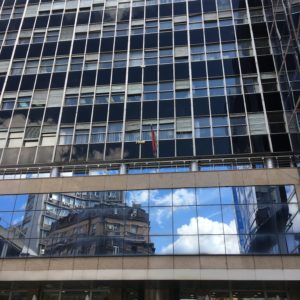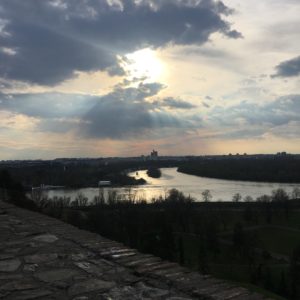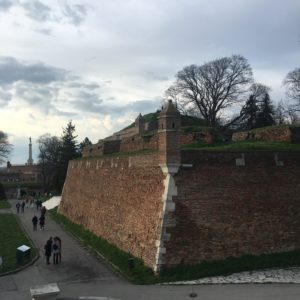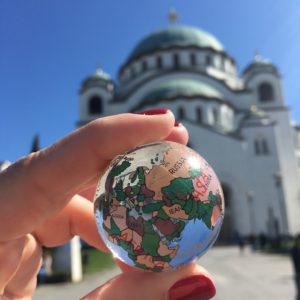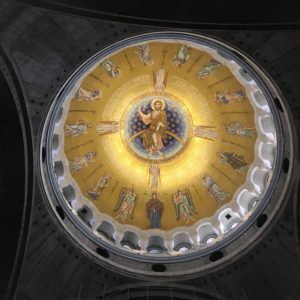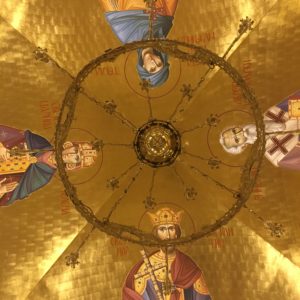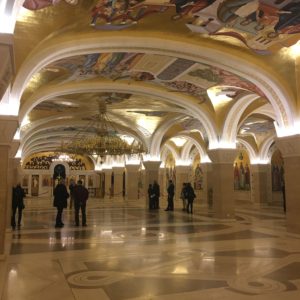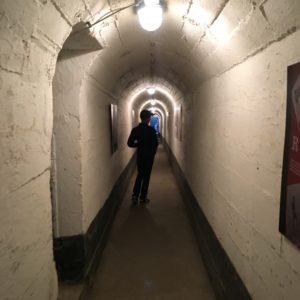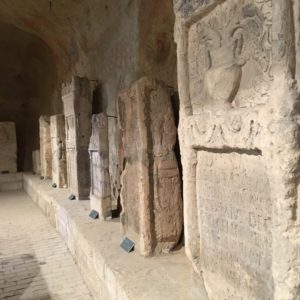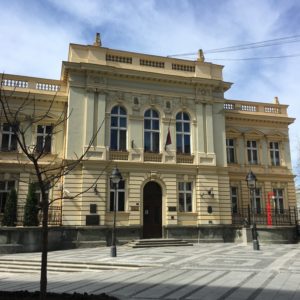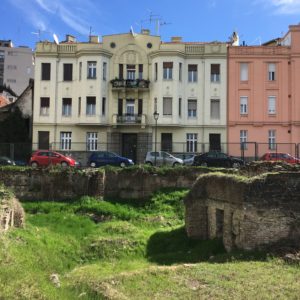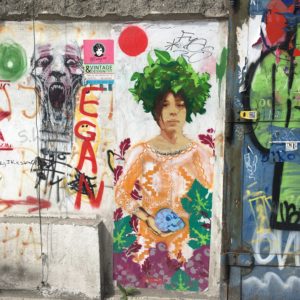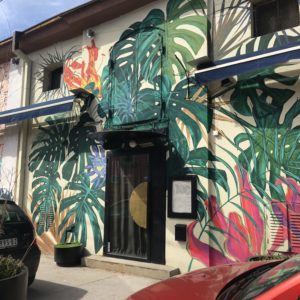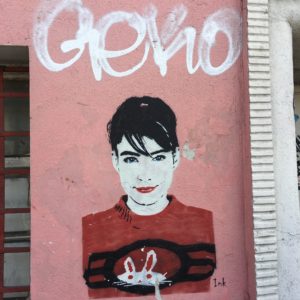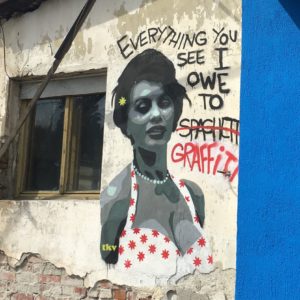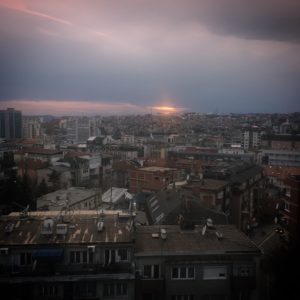 So back at the beginning of April I traveled from Belgrade Serbia to Pristina Kosovo via bus. Truth be told I was really nervous about this trip. I didn’t know anyone who’d traveled to either countries and there’s not a ton of information available online. What I could find said that the bus was the way to go, so I made my way to the bus station . The bus station in Belgrade looks like every bus station the world over. Once I figured out which bay my bus was boarding from I made my way there, stowed by bag in the underneath compartment and boarded. Once I got on the bus though I couldn’t read the seat number so I stood there kinda clueless until this local man pointed me towards the center part of the bus. Now blocking the row to my seat was this elderly man with wispy greying hair, thick unruly eye brows and a short stature. He was trying to get his small bag into the compartment above. Turns out he was my seat mate, so I helped him get his bag up and he took the window seat and I had the aisle.
So back at the beginning of April I traveled from Belgrade Serbia to Pristina Kosovo via bus. Truth be told I was really nervous about this trip. I didn’t know anyone who’d traveled to either countries and there’s not a ton of information available online. What I could find said that the bus was the way to go, so I made my way to the bus station . The bus station in Belgrade looks like every bus station the world over. Once I figured out which bay my bus was boarding from I made my way there, stowed by bag in the underneath compartment and boarded. Once I got on the bus though I couldn’t read the seat number so I stood there kinda clueless until this local man pointed me towards the center part of the bus. Now blocking the row to my seat was this elderly man with wispy greying hair, thick unruly eye brows and a short stature. He was trying to get his small bag into the compartment above. Turns out he was my seat mate, so I helped him get his bag up and he took the window seat and I had the aisle.
For the next five and a half hours I had the most pleasant conversations with this man. It was one of those experiences you would never, ever get if you didn’t leave the comforts of your own country. Where you just trust in the kindness of strangers, and quickly a person touches your heart. His nick name was “Galle” and he was a pilot in the Yugoslav army back in the day. He was on the way to visit a sick brother who lived in Kosovo, while he lived in Serbia. Thankfully, he spoke some English and so we chatted about history and current world events. He translated his Serbian newspaper articles to me, and tried to teach me the Cyrillic alphabet which was really a hopeless undertaking. We shared our snacks with one another and napped off and on. As the only foreigner many of the surrounding passengers were interested in what Galle and I were chatting about so sometimes he included them by translating our conversation.
Since I was the only tourist on the bus I was the only one who’s passport was stamped at the border- the others traveled on ID cards between the borders- if they had their passports stamped it would be difficult for them to return to Serbia. As with most bus border crossings an employee of the bus collects all the IDs and takes them into the immigration office/booth and then returns them to you once the bus is through the border. At both borders an official boarded the bus and walked the aisle but no one was further questioned. Easy peasy.
Galle later told me that he was meant to travel the following day, but seeing as the weather the next day was supposed to be stormy his son urged him to go today. We both expressed what a blessing it was that he traveled today instead of the next day, otherwise our paths would not have crossed. Once we arrived in Pristina I helped him carry his bag off the bus. He was waiting for a relative to pick him up and I was taking a taxi to my hotel. Before we parted ways I asked him for a selfie. I think this was a first for him, or maybe there was a miss communication because when I got my phone out and bent down to take a picture with him he kissed me on the cheek. So I’ve got this hilarious photo of me laughing and him looking kinda confused. We hugged and parted ways, and my heart felt really full after having such a pleasant journey.
The history of Kosovo, like much of the Balkans is complicated and filled with emotion. 95% of the population of Kosovo are ethnic Albanian Muslims, although Kosovo is a very secular country where people identify as being Muslim but don’t really practice. 1% are Serbs who are Russian Orthodox and the other 4% is Romas, Macedonians, Turks and a variety of other minorities. Kosovo is the youngest country in Europe- it self declared independence in February 2008 making it 10 years old. Since it is self declared it’s kinda a mixed bad as to which countries recognize its sovereignty. Most countries in the EU and more than half of the members of the UN do. Kosovo also has the youngest population in Europe with nearly 40% of its population under the age of 25. This was super evident walking around the streets of Pristina- it had the feeling of being a college town as everyone was very young.
So here’s my very basic explanation of the Kosovo war. The late 1980’s saw increased nationalism amongst ethnic groups in Yugoslavia (what is present day Slovenia, Croatia, Macedonia, Montenegro, Bosnia and Serbia-which had 2 autonomous areas Vojvodina and Kosovo.) People of Yugoslavia identified as either Catholic, Orthodox or Muslim. Increased nationalism led to civil unrest and in the case of Kosovo the Serb minority felt prosecuted by the Albanian majority. This civil unrest though was felt across the entire region and in the early 1990’s Slovenia and Croatia declared independence which led to the collapse of Yugoslavia. The war in Slovenia lasted only 10 days. Croatia was not as lucky. During this time Macedonia also declared independence. The Croat- Bosnian War then broke out in 1992. In 1993 the US got involved in the conflict after Bill Clinton was elected. Sanctions were imposed throughout the region to prevent the further outbreak of war. Peace was made between Croatia and Bosnia in early 1994. Eventually they banded together to fight against Serbia- later they were assisted by NATO. In Serbia tensions increased in 1996 with the formation of the KLA (Kosovo Liberation Army) . The Kosovo war started in March of 1998. In 1999 NATO assisted Kosovo forces, and conducted a series of bombings in Serbia which eventually led to the with drawl of Serbian troops. In 2006 Montenegro became independent separating themselves from Serbia. 2 years later with foreign troops still in Kosovo, Kosovo declared its independence. Although as previously stated this is not recognized by many countries. This is obviously a very overly simplified summary of the events. War atrocities were committed though out the region. Thousands of people are still missing. Millions of people were displaced throughout the region from the early 1990’s until the end of the conflict in 1999.
My initial impression of Kosovo was that it was much more run down than Belgrade felt- it’s still very much in the “developing” stage, and the population appeared very young. Also they love the US of A here. I’ve never seen so many American flags outside of 4th of July celebrations in the U.S. This makes total sense seeing as without NATO help the war would’ve likely raged on. I hired a local guide named Bekim the take me around the country, as there were several historical places I wanted to visit. This ended up being the best way to see the country- Bekim has a degree in anthropology and was a wealth of knowledge. If you’re traveling to Kosovo let me know and I’ll forward on his details!
So Bekim and I started the day out driving south from Pristina to the town of Gracanica. This town has a Serbian majority population and there is a moving monument to the 500 Serbs from this area that are still missing. Not noted on the monument are the estimated 700 Albanians from the area that are also still missing. From here we visited the monastery with the same name as the town. It was built in 1321 on the ruins of a 6th century basilica. The monastery itself is really stunning and built in a Byzantine style. No photos were allowed on the inside but there was a church service taking place while we were there so I was able to sneak in and watch. From here we drove south towards the snow capped mountains near the border of Montenegro. The countryside of Kosovo is lovely. It’s green and the air is fresh and it reminded me a lot of driving thru parts of Canada. Next up we visited the Patriarchate of Pec which sits alongside a river. It was built in the 13th century and used to be where the Serbian archbishop resided. Now nuns live there. There are ruins in front of the monastery and mountain views behind it and the whole complex has a peaceful air to it.
We then wandered through the old bazaar of Pec and went for a traditional Kosovo lunch which is mostly kebab style meats with vegetables and bread. All very good. Naturally I paired mine with a local Peja pilsner. After lunch we visited a kulla which is a traditional village stone house. It consisted of three floors- the main floor is for the animals and storage, the first floor the living area for the family and the top floor was for visitors and entertaining. We then drove south a bit to Decani Monastery my favourite site of the day. It was built in the early 1300’s and is under the protection of NATO forces and you must show proper ID to enter. During the Kosovo war the monastery was used to shelter refugees. The church is build in the Byzantine style and inside there are over 1000 frescoes including one of Jesus with a sword. While we were there it started to cloud over and rain lightly which added to the tranquility of the monastery. It was a real highlight for me.
Our last stop was to the city of Prizren which is in the south on the way to Macedonia. Prizren is the second largest city in Kosovo and it’s legit adorable. It reminded me of Turkey and there are postcard worthy views from the old stone bridge that crosses the river with the mosque and fortress in the background. It will blow your Instagram up. For realz. We wandered around the area near to the river and visited a mosque and then stopped off for ice cream before heading back to Pristina. Booking my tour with Bekim was a great way to fit several sites into one day.
I then spent one more full day in Pristina where I visited the Kosovo museum which has a lower floor dedicated to ancient history of the region and an upper floor dedicated to Kosovo’s more recent history. I found it very interesting. Then I did what I always do in a new city- I joined a walking tour. On a rain drenched afternoon we visited the Old Town and saw the clock tower, mosque, and bazaar before visiting a traditional home at the Ethnology museum. We then walked over to the newer part of the city and visited the Newborn monument signifying the country’s independence. Across from it is a new monument dedicated to the 20,000 women (and men and children) who were raped in the Kosovo war. We then walked thru the University past the library which if you google it is on many lists of the “ugliest buildings in the world.” And truthfully it is pretty ugly. But that’s just my opinion. We then visited the Mother Teresa Cathedral which is new and huge and way too large for the minority catholic population of the country. The pews have what looks like American eagles on them, but to be fair they could also represent the Albanian flag which also has an eagle on it. Either way it was confusing.
My favourite building in Pristina was the highly controversial church called the Christ the Savior Cathedral. It was built illegally on the grounds of the university which is not supposed to have a religious affiliation so the church was never completed. It just stands there like a bombed out building, although it was in fact never bombed, looking eerie and abandoned. Naturally my love of abandoned and decaying buildings had me taking tons of pictures of it, and the sky was stormy that day so it added to the ambiance.
From here I took the bus to Macedonia…..
